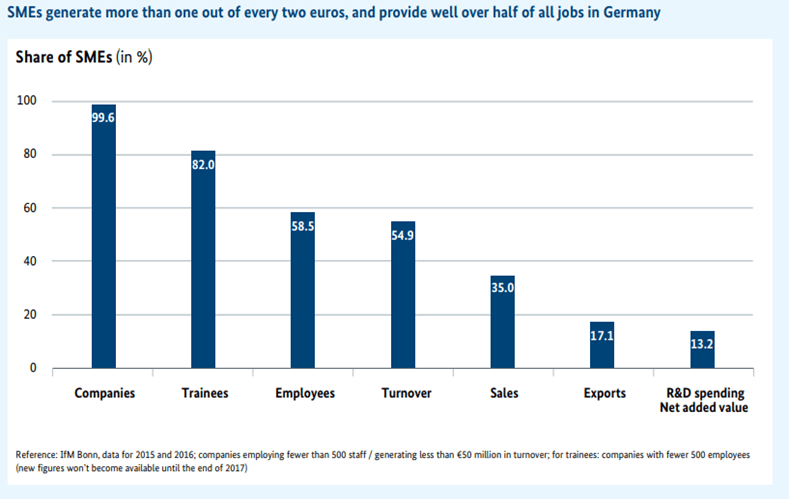Digital Transformation is a fundamental change to business operations by implementing multiple digital technologies across the whole business or several major areas.
We hear a lot about Digital Transformation in large corporations. The struggles and benefits are well known if we talk about large-scale projects across multiple departments and regions. Even before Covid19, it was apparent to many that the benefits of moving business processes into a digitalised, automated environment greatly outweigh the growing pains of Digital Transformation.
Many smaller companies do not immediately see the benefits of Digital Transformation. The ease of passing on information in the smaller circle and perhaps the family nature of the business made the benefits of such change less clear. Additionally, the costs might look high. Therefore, this transformation left behind many small and medium-sized companies.
SMEs are falling short in following big businesses in adopting new technologies. This is especially apparent in Europe. This is not a minor issue, as small companies occupy a large chunk of the European economy. In Germany, SMEs create over 35% of companies‘ turnover, according to a report by the Federal Ministry for Economic Affairs and Energy of Germany.

Some of the most common complaints regarding digitalising business processes for SMEs include the inflexibility of „out of the box“ solutions to fit the specific business need. SMEs often require only a fraction of the offered functionality and usually do not want to pay for the complete solution.
Additional complaints include time and effort spent learning new software, something small businesses often feel they cannot afford to lose.
However, we want to encourage small business owners to consider the cost of inaction.
We are witnessing not just a global Digital Transformation but a form of the digital revolution:
– Low code and no-code solutions bring innovation closer to an everyday user.
– The global pandemic pushed many businesses out of their comfort zones and demanded quick, innovative solutions for survival.
– The surplus of data on consumer behaviour completely transformed how we think about marketing.
We know from history that even the most successful businesses and prosperous communities that did not implement the tremendous new technological advances of the industrial revolution found themselves lost in history.
I believe now we are at the point when keeping up to date with technological advancement in the office environment is not only a matter of growth but of survival.
How do post-pandemic trends affect SMEs?
The world will never look the same; the pandemic left many businesses crippled through disrupted supply chains and changes in consumer behaviour. The current geopolitical situation adds to the crisis through rising inflation and uncertainty.
According to Fairlie (2020a), the number of working business owners plummeted from 15 million in February 2020 to 11.7 million in April 2020 because of COVID-19 mandates and health- and economic-driven demand shifts.

The loss of 3.3 million active business owners (or 22%) was the largest drop on record. When conditioning on working roughly two or four days a week, the losses are even more prominent (28% and 31%, respectively). Total hours worked by all business owners dropped by 29%. Although incorporated businesses are more growth-oriented and stable, they experienced a drop of 20% from February to April 2020. The findings indicate a partial rebound from April 2020 numbers in May and an additional rebound in June. The number of active business owners bounced back by seven percentage points resulting in a 15% drop in business activity from February to May 2020, and an additional five percentage points rebound in June, resulting in an 8% drop in business activity from February to June 2020.
Another study demonstrated that SMEs that were most innovative and quick to learn and engage in networking events could recover from the pandemic’s effects. Some SMEs were even able to grow their business.
The key to successfully leading a business through a crisis is the ability to react and adjust to the environment. Digital Transformation, in that view, is a necessary tool in optimising business processes, making them more agile.
Step-by-step guide for digital Transformation
Now that we have established the need and urgency for SMEs to adopt new technologies and engage in Digital Transformation, the question of how remains. The following steps will guide you to successful Digital Transformation:
Step 1: Start by understanding what Digital Transformation means for the industry you are in and your company precisely.
Introducing new technology to any company, no matter the size, is no small task. It cannot happen overnight. Though Digital Transformation, without a doubt, is no longer just a buzzword, there is still no one clear definition for it, which means that each business must decide for themselves what exactly it means for their company. This will depend on individual needs and goals. Does your company look to optimise operations, create a modern workplace focusing on collaboration, improve data security and flow of information or focus on bringing customer journey and experience online? This is for the business to decide.
Step 2: Analyse and determine your current capabilities, strengths, and weaknesses.
Some will argue that this is one of the most critical steps in the whole process. Proper business analysis is key to establishing accurate, meaningful, and achievable goals.
Once you have established what Digital Transformation means to your business and the areas you want to focus on, analyse how the processes look now. What is the current technology stack? What is the current skill set of your employees? Doing deep analyses will determine the main pain point for your business. For example, you might underutilised your customer data, leading to poorer marketing campaigns. Another example is slower operations which lead to customer complaints about the delivery time or project delays.
When doing your business analyses, it is crucial to focus on the customer first. Digital Transformation should not and must not disturb current ongoing operations and business, but rather enhance it in the timely manner and pace suitable to your business.
Step 3: Establish your digital strategy and create a roadmap.
With the definition of digital strategy and significant pain points identified, we can now move forward to a more concrete task of identifying the main goals of the Digital Transformation.
Digital strategy will allow your company to select and prioritise systems your business would like to adopt. Establish communication and ways to introduce Transformation to your team and the organisation. Another critical element of the strategy is identifying metrics to assess the success of Digital Transformation. It is also the time to think about GDPR compliance, the need for Cyber Security checks and future scalability.
With the right strategy in place, a practical plan or a roadmap needs to be set up. Businesses must allow time and space for transformation. Companies must think about what will be changed first. How to ensure the implementation of the new system does not disrupt day-to-day business activities.
Step 4: Select the right tools and ensure the right skills are in place.
Depending on the type of Digital Transformation business SME decides to focus on, multiple solutions, tools and platforms are available today.
Some obvious choices, like Microsoft, SAP and Salesforce, can offer many out-of-the-box solutions across a variety of business functions. These solutions are tested and implemented by many. On the flip side, multiple emerging smaller companies are offering specific solutions which can be tailored to the needs of a smaller niche company. HansaCloud.com, Monday.com, Asana, and ZoHo provide such solutions. Though coming from no small company, even GStui can offer a cheaper, more elegant solution to address everyday business operations. There is an option to use a Digital Transformation platform, which allows updating across multiple business functions and simultaneously ensures that all the different solutions are interconnected and allow for the flow of information seamlessly.
Finally, new low-code/no-code platforms such as Power Platform by Microsoft provide businesses with unique opportunities to create tailor-made solutions based on a trusted platform, ensuring the solution’s security, reliability and scalability.
Step 5: Inform and guide your company through the process.
Change does not come easy to all of us, and most do not like unexpected changes. IT is in your interest to guide employees and clients through the process while simultaneously promoting the new system’s benefits. When all the decisions are made, your company is ready to move forward with DIgital Transformation, ensuring that your roadmap includes communication plans both across the company and towards your customers.
In Conclusion
Addressing Digital Transformation might seem like a herculean task. But it is one that sooner or later must be done to survive and grow as a business.
HansaPlus has been guiding its clients through Digital Transformations for the past 20 years and is ready to help SMEs through every step. We offer our services in assessing your current IT solutions, consulting on business strategy and practically implementing new technology.
Our experts will help you choose the right tools for your business, and our developers can customise or build new solutions which fit specific goals your company wants to reach.
We offer our skills and know-how to find your company’s most cost-effective and sustainable solution.

